Hugh
Smith:
A View from the Anchor Desk
For a little over a generation Hugh Smith served WTVT as a reporter, anchor, and news director. His tenure occurred during a time of radical change in the way news was covered, both technologically and editorially.
Portable video cameras and
satellite trucks created new opportunities and editorial challenges.
The importance of local political coverage, education, and crime was
also transformed as competition grew more intense and the economics of
television broadcasting became more scrutinized in the form of ratings and
demographics.
“Big 13” paid a visit to Hugh Smith in May, 2002, to talk about his life in journalism and his career at WTVT.
# # # # # # # # # # # # # # # # # # # # # # # #
How did you become interested in broadcast journalism?
“I grew up in a small town called Pipestone, Minnesota, and developed an interest in radio by listening to the great broadcasters like Edward R. Murrow and his gang that included Erik Severeid, Douglas Edwards, and Robert Trout.
Every night radio would have mysteries, stage dramas, or comedies. Back in those days, we also had the Mutual Broadcasting System, that programmed detective and mystery shows. Then there were Bob Hope, Jack Benny, Burns and Allan, and Milton Berle.
Where
most kids would be out playing baseball, I made radio consoles out of cardboard,
and set them up in the basement of my house.
I’d go down there and talk by myself on the cardboard microphone and
pretend I was broadcasting, by reading
aloud out of newspapers and magazines. My
mother always said I should have been a lawyer because I talked so much.
Looking back, that probably wasn’t bad advice, because they make a lot
of money.
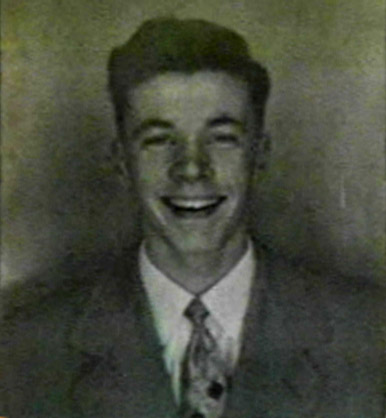 |
Later on, we lived for a couple of years in a little town called Minot, North Dakota and it had one radio station, KLPM, which was a Mutual Broadcasting affiliate. I’d go there and ingratiate myself to the staff and they allowed me to sit there in the control room for hours and watch them do radio broadcasts. Out of that I decided early on that being a radio announcer was a rather hazardous way of making a living. I saw people come and go pretty rapidly in the business, and realized that playing records and announcing station breaks was not the way to make a living in the long-run. I had a basic curiosity about things so I combined that with my interest in broadcasting and studied journalism at the University of Minnesota." |
In the spring of 1955 Hugh and two other journalism students were candidates for editor-in-chief of the university's newspaper, the Minnesota Daily.
A Board of Publications elected Hugh as editor. As part of the arrangement, Hugh chose his own staff. Hugh graduated from the University
of Minnesota and began his broadcasting career in 1956. It was during this time that he married his first wife, Joan.
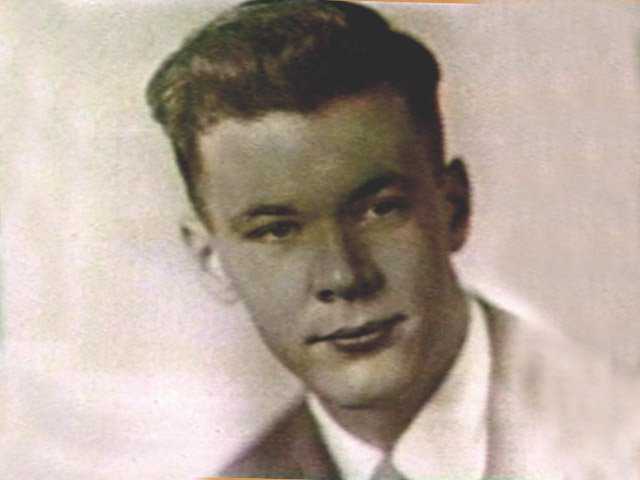 |
I went from WCCO to WHAS-AM and WHAS TV and radio in Louisville, Kentucky. The first day I went to work at WHAS they lost power and went off the air. I used to joke that some people have a face that could stop a clock, I had a face that could knock a station off the air."
|
Although Hugh found television a breeze he ran into unexpected difficulties in radio.
“I never had any
trouble doing television, but I had enormous problems becoming a radio
newscaster. We had 15 minute-long
newscasts, and I began to wonder if I could even say my name and make it come
out right. TV, no problem.
And there were plenty more things to be distracted by in a TV studio than
a radio studio. One of the long
time announcers at WHAS took me aside and said ‘Look, you’re doing a fifteen
minute newscast and it seems to be
scaring you. Look at it as three
five minute newscasts and kind of pace yourself.’
I did, and didn’t have any problems after that."
Hugh found a role model in WHAS-TV anchor and reporter Bill Small.
"Bill would question people, and he was an absolute genius at getting people to answer the question he asked...not the question they wished he had asked. If he didn't get the answer the first time, he just kept at it. You could see him mentally circling around these people. He would keep asking he question in twenty different ways until he finally got the answer he was after. I was entranced by that, and learned a lot from Bill Small. He had a major impact on my professional broadcast life."
While living in Louisville, the Smiths adopted a son, Grant.
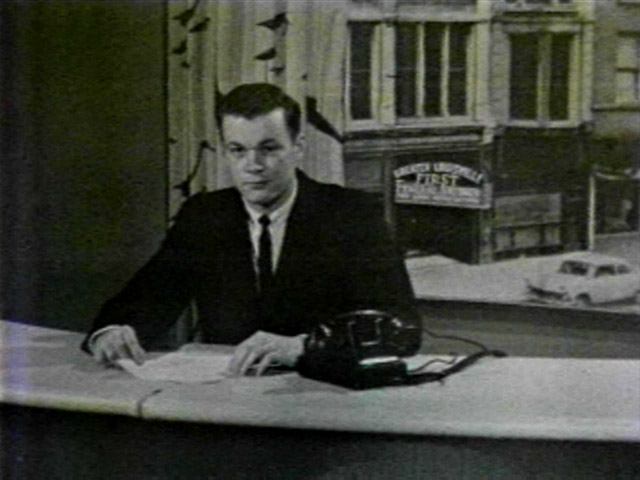
Hugh's experience in Sioux City lead him to seek work...at WTVT!
"I stayed at WHAS for about five
years, and figured that I should be a news director, which was dumb because I
certainly wasn’t qualified. I put
an ad in Broadcasting Magazine, and I got two responses, one from Clovis, New
Mexico, and the other from Sioux City, Iowa.
I said, ‘Well, Sioux City has got to be better than Clovis, NM."
Hugh contacted WTVT and was surprised to get an immediate response.
“WTVT’s assistant manager, Bob Olson, did something that was rather unique. He flew out to Sioux City to see me. And believe me, flying from Tampa to Sioux City in the early 60’s was not an easy experience.
Bob watched me on TV from his hotel and called afterward and said ‘come on
down and let’s talk.’ We had a
good conversation…no formal offer was tendered. He had to check with the office back in Tampa.
Bob said to call him in the morning.
I did and he offered me a job as a newscaster and I took it.”
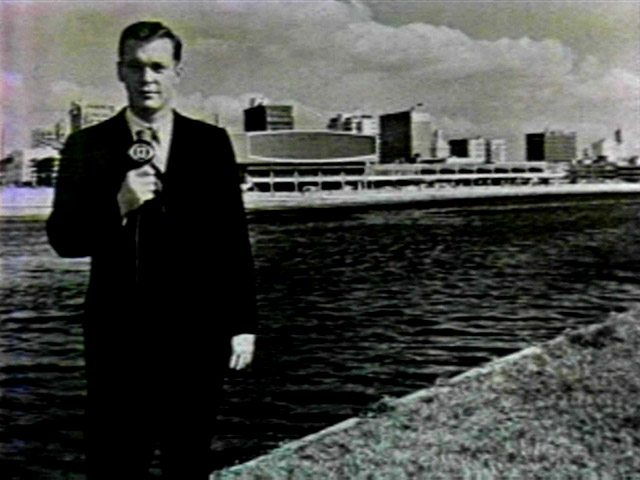
Hugh reporting from Tampa
(Curtis-Hixon hall seen in background)
The Smiths adopted another child, Ward, in Sioux City
before their move to Tampa. Hugh arrived at WTVT ahead of his family on Labor Day,
1963. He reported to
the news director, Tom Wright.
"Tom had me out
to his house for dinner the first day I arrived in town.
We had a general conversation about the philosophy and the attitudes of
WTVT. For instance, we didn’t pay
as much attention to crime then as stations do now.
Whether we wrong or right about that I don’t know.
We paid a whole lot more attention to local politics, local education.
The station put me up at the old International Inn, which was THE place to stay in those days. I hadn’t moved my family out to Tampa yet because I had to get there first and start the job. I’d been living at the hotel for two weeks on the station’s dime and someone said ‘You are looking for a place to live, aren’t you?’ Our first house was in the Town and County area of Northwest Hillsborough County.
My first
assignment was to anchor the Pulse noon news.
I wrote for the six o’clock news until the anchor, Tom Dunn, took a job
with WCBS and moved to New York City. I
took over six and did that for a while and then told Ray Dantzler that I’d
like to do the 11 o’clock as well and he said ‘Yes.’"
Hugh Smith on the local government beat
Hugh continued to serve as a reporter, covering the local
school board and county legislature. He
remembers well a visit from President Kennedy.
“One of the first
outside assignments I had was covering President Kennedy when he came to Tampa
in November of 1963. I was with the
live mobile unit in the old Al Lopez field.
Kennedy delivered a speech concerning
the United State's policy towards Cuba and the fact that he would be running
for reelection in 1964. When
Kennedy finished, he walked down
the steps and mingled around the fence and shook hands with the crowd.
I’m sure the secret service went wild.
There was a rather
unusual arrangement between Channel 13 and Channel 8.
In those days, neither station had the large staffs or remote
capabilities they have today. So,
the two stations split of coverage of the events.
Channel 8 would cover events A and C, and Channel 13 would cover B and D. We picked up each other’s live signal and had live,
continuous coverage. I don’t know
of any arrangement like that since.”
Hugh and his wife adopted a third child in Tampa, naming
her Karen. Hugh's career at Channel 13 was going smoothly, and he was
about to be the first WTVT on-air person to be televised in
color.
“In June of 1966, we heard a rumor that Channel 8 was going to go local live color real fast. Well, we weren’t about to be beaten by that, but our new color cameras were still being evaluated by the engineering staff…they weren’t up and working yet. I was anchoring on a Saturday news block, and one of the color cameras was brought into the studio. There wasn’t time to put the camera on a pedestal, so they mounted it on a crate, and aimed it at me. Of the three people in the news block that night, I was the only one that got the color camera treatment. Paul Reynolds was doing sports that night and was very upset about this. When his segment came on, Paul said ‘Hi, I’m Paul Reynolds in living black and white.'
Because I was wearing
a dark blue suit, the promotion director, Walt Rhoads, brought in an enormous
red boutonniere for me to wear. This
flower seemed to be the size of a baseball, so I trimmed it down a little bit
and we had a dash of color."
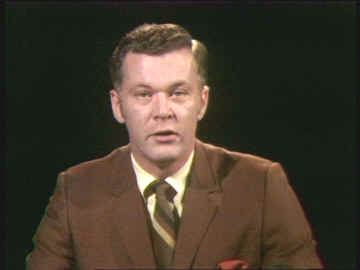
Hugh was the first WTVT anchor to appear in color
By 1968, Hugh had been with WTVT for five years, and
changes were in the wind.
“I had been Ray’s
(Dantzler) assistant news director for a while, and heard an interesting rumor from Paul Reynolds. He told me
that Ray was going to become program director and that I was to be news
director, which I thought was baloney. Paul
had a reputation for setting up people, and I said ‘You’re nuts.’
The next day, Gene Dodson comes into the news room and grabs me by the
arm, propels me into the news director’s office and told me ‘you’re going
to become news director and Ray Dantzler’s going to become program
director,' just like Paul said.”
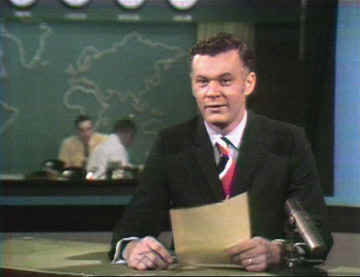
Hugh in Channel 13's color communications center (1969)
Dodson's support of Channel 13's during ratings ups and downs was unique and definitely 'hands off.'
"I didn’t report to Mr. Dodson directly although I met with him every morning with for the daily editor meeting. My boss was Ray Dantzler…the director of news and public affairs. Only very few people were allowed to call Mr. Dodson ‘Gene,’ to the rest of us he was Mr. Dodson or ‘Mr. D.’ A very formal relationship. He had a news background, and was once with the A.P. (Associated Press), and so he understood what news was all about, and he understood that it took some money to do it properly and he spent it."
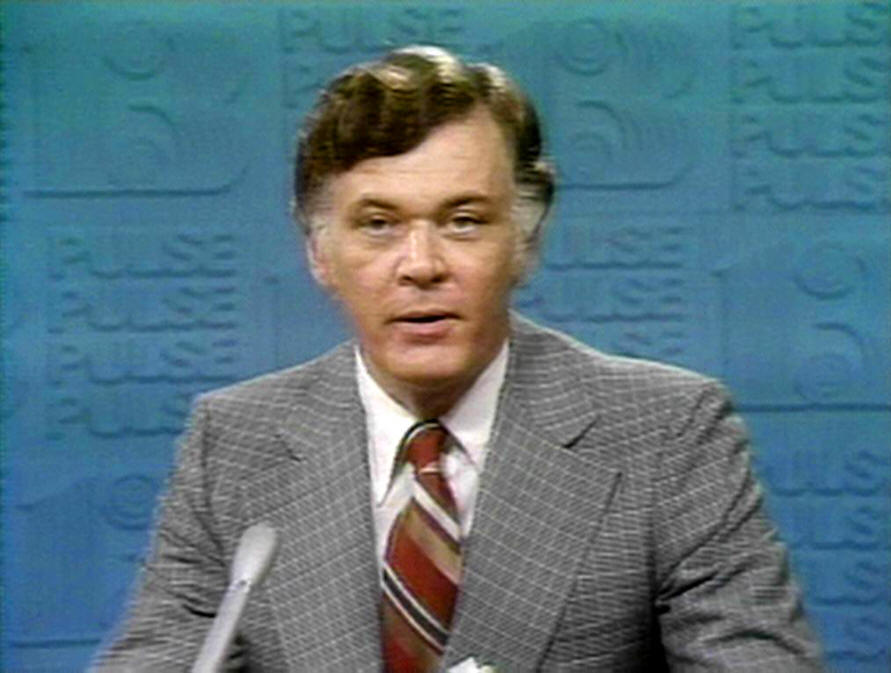
HUGH SMITH ANCHORS PULSE NEWS at 6PM
As news director, Hugh managed a staff of 30 reporters,
photographers, assignment editors, engineers, and on-air talent.
His ‘typical’ day started in a meeting room.
“I would come into the station around eight or eight thirty, and there would be the daily editorial meeting with Gene Dodson. Afterwards, I would pick up a silent 16mm camera and a sound-on-film camera. I had a company-assigned car and I would go downtown and nose around to see what kind of stuff I could pick up for the day.
Hugh and Pulse Assignment Editor Chip Collins
I had kind of
assigned myself to the Hillsborough County school system, the legislative
delegation, and to some degree the Hillsborough County commission.
I shot my own film, everyone did that in those days, either silent or
sound-on. If I needed to appear
on-camera, I would use a portable
light stand to gauge my height and where my head would be…frame up the shot,
and then walk around and take the place of the stand.
We had no field producers…it was a one-man band.
I tried to be back around the noon hour, get the film to lab, and take
care of whatever managerial duties were needed. The staff for Pulse news was around 30 people, and there were
always issues to settle.
If I had covered a
story that day, I would get the film, write the script, and edit it myself, and
do all the other things that needed to be done to get the six o’clock news on
the air. Although we were
fairly well organized, I suppose there was a certain amount of chaos."
Channel 13’s news coverage included many reports filed
from the state capitol.
"We had a full time reporter in Tallahassee with a teletype connection to our newsroom in Tampa. During legislative sessions, in addition to the full time reporter in Tallahassee, we would send a different person each week from the Tampa newsroom to spend a week helping with the coverage. It was awfully good experience for the members of our staff and I went up myself on a couple of occasions. We paid a lot of attention to what was going on in Tallahassee.
In the 70's, our Tallahassee bureau chief was John Hayes, and then he was promoted to Tampa to become assistant news director."
In addition to his anchor duties, Smith also was a field reporter
covering the Hillsborough County Commission and school system
Was there any pressure to deliver high ratings?
“I saw the periodic ratings that came out every few months. No pressure was put on me if the ratings fell…and they sometimes did. I remember attending a party with Channel 13 sales execs and some of our clients, and Gene Dodson was there. And that particular year the numbers weren’t doing too well, I don’t remember why. Dodson stood there and said to somebody ‘I know the numbers are low, but heads are not going roll because I don’t believe in that.”
And what about the competition?
“Eight was our only competition at the time. Arch Deal was a fixture in the Tampa Bay area before I arrived. In fact, Arch worked at Channel 13 once for about two weeks. He was their prime anchor, and considered the guy to beat.”
When Smith learned that Arch Deal had almost died in a parachute accident, he did something no anchor had ever done before: He interviewed Arch Deal and ran the story on Pulse! The two-part exclusive interview (Channel 8 did not cover the story of their own anchor....!) created a sensation and publicity for WTVT's news department.
From the beginning of television news, field reports were always produced on 16mm film. In the early 1970’s, portable ¾” video tape became practical when combined with ENG portable cameras, which led to further technological innovations.
3/4" Umatic ENG editing system
"We began with one or two portable tape machines, and the thing expanded and grew and film became obsolete by the late 70’s.
500 feet above Tampa
We pioneered live remotes back in 1976. Duane Martin in engineering had been working on this for a long time, and the station had purchased a small microwave transmitter and a small camera. We decided to do the live premiere from a helicopter. That night, I anchored some of the news from the helicopter over downtown Tampa. I heard later about the reaction from Channel 8. Their people were just climbing the walls over this, because we had beat them."
The new era of
live reporting gave Hugh some reason for pause.
“Covering news events live was a great concern to me…and it is to this day. My problem with it was the elimination of the editing process you go through in your own mind. You had to be ready to go, your thoughts together, you had to be able to talk your way through a story with all the facts at hand, whether you had all the facts at hand. The fact that it left out the process of being able to sit back and think about this for awhile, or a couple of hours, still bothers me. You can go live routinely, so a correspondent is dropped into an area and is expected to instantly become an expert. But that’s the nature of the beast.”
Hugh and Walter Cronkite
By the mid 1980's, the station was being managed by former Pulse anchor and news director Crawford Rice.
"Crawford became concerned about me doubling in brass…being both an anchor and a news director. Crawford's concern was that there just weren't enough hours in the work day to do justice to both jobs. For instance, as a reporter/anchor, I spent a lot of time out on the street gathering news, then working on the 6 p.m. broadcast back in the station. That left little time to work with the rest of the news staff or to meet with Crawford, aside from the daily morning Editorial session.
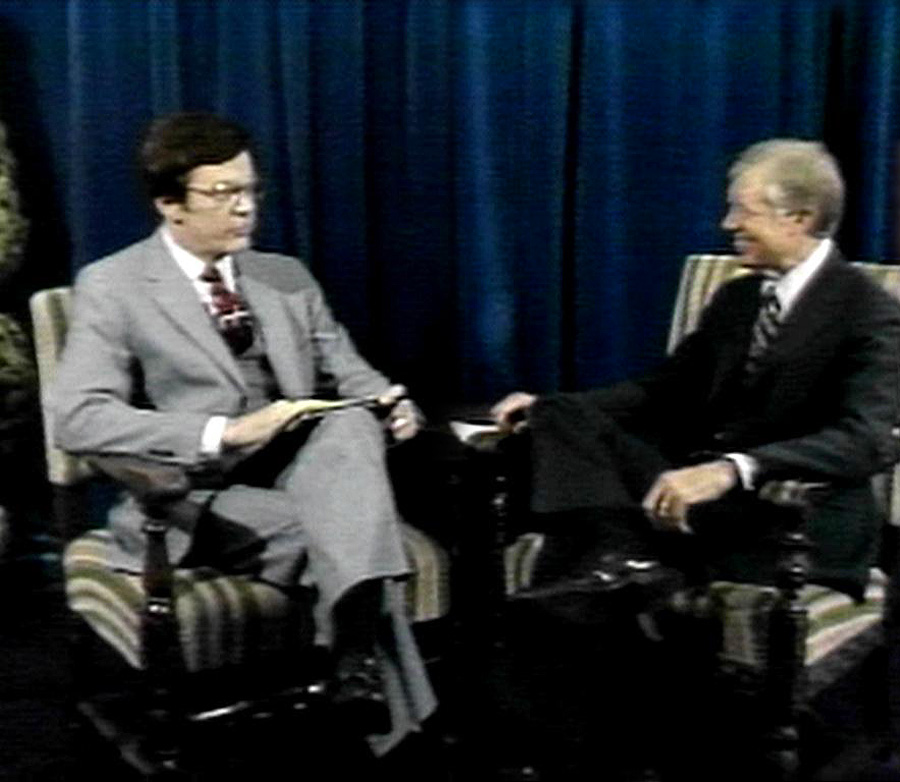
HUGH WITH PRESIDENT JIMMY CARTER
One day in a morning meeting,
Crawford said to me, 'You know, Hugh, you’re like a
guy standing on a dock with one foot in the boat and one foot in the dock.
Which way are you going to go? I
think it’s time we split these jobs.'
He said ‘You make
the call, I’m not going to tell you which one to do.
If you want to fly the desk…fine.
If you want to give up the managerial part and just be an anchor,
that’s fine…you make the decision.'
Hugh decided to stick with anchoring, and gave up the position of
news director
I made the decision to stay on the air and not be a manager of a department any more. That way I didn’t have to go home worrying about 40 or 50 different people. That’s being a little selfish, I’m sure.”
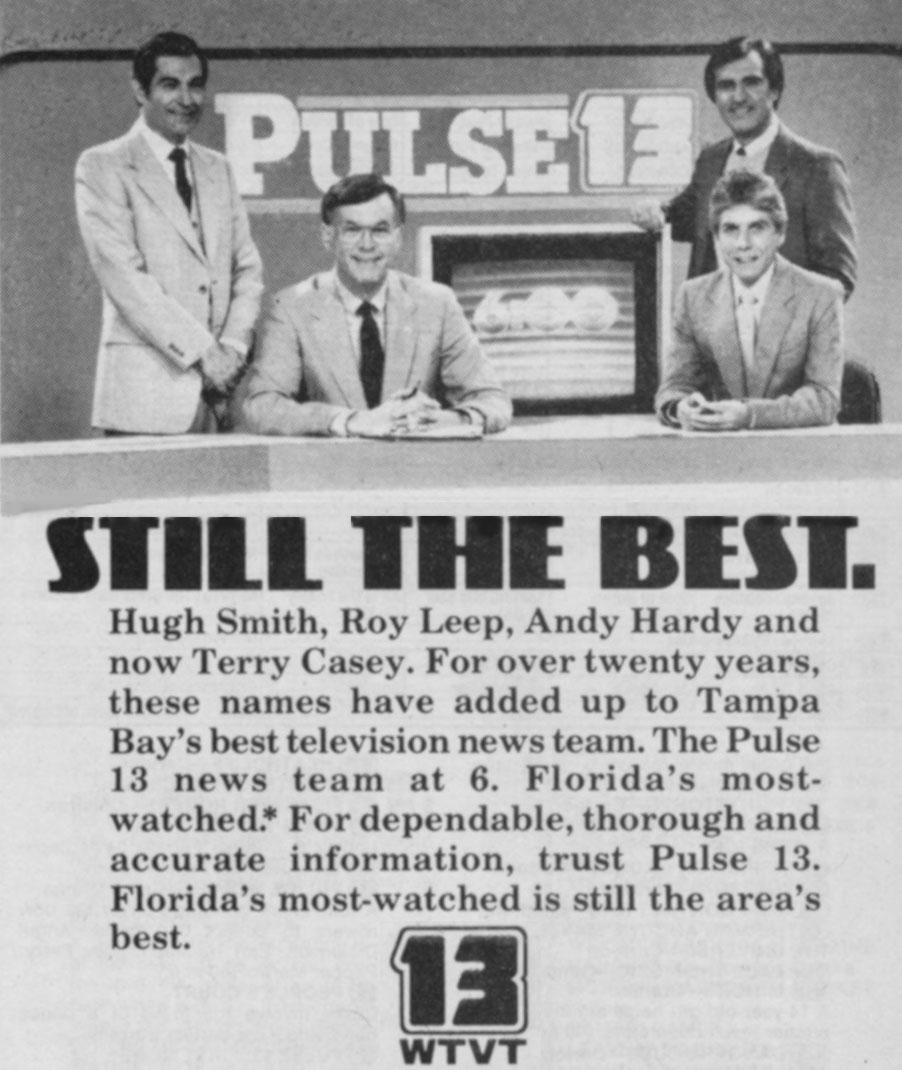 |
Former Project 13 host and producer Ray Blush, who had
become Assistant News Director upon the departure of John Hayes, became Channel 13's
News Director, with Smith serving as anchor. By the mid 1980's, news competition from WFLA and WLCY
(WTSP)
was shrinking WTVT's ratings lead. One radical change to cope with the
situation involved dropping the name "Pulse" from the newscasts.
This 1984 newspaper ad shows Roy Leep, Hugh Smith, Andy Hardy, and Terry Casey. |
Roy Leep, Hugh Smith, Kelly Craig, and Andy Hardy
of Channel 13's "Eyewitness News" (1985)
"The change from "Pulse" to "Eyewitness News" resulted from polling which revealed that viewers didn't seem to know what "Pulse" meant. Perhaps the old tag-line "The Heartbeat of a Changing World" might have made the meaning clearer, but nevertheless, "Eyewitness News" was born. The change was made under different ownership and while Bob Franklin was News Director.
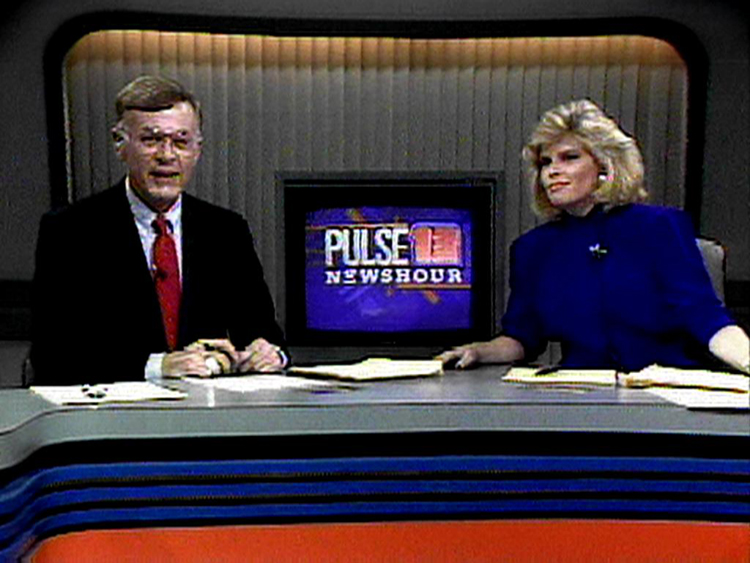
HUGH AND KELLY CRAIG
As for the other stations in Tampa and St. Petersburg, Channel 10 never was much of a competitive factor until the day they surprised the market by putting a leased helicopter into service. Channel 13 neither owned or leased a chopper of its own while I was News Director, so there was little we could do about that except cover the news as thoroughly as possible through other means.
I've always felt we met the increased competition from other stations through the strength and talent of the people we employed. They were bright, quick, and absolutely determined to out-report and out-photograph the competition."
Hugh summarized his feelings about spending a generation with WTVT news.
“It was the greatest experience I ever had. Going there was the best decision I ever made. I was there a little more than 27 years….15 years as news director, and sometimes anchor on top of it."
'Big 13' thanks Hugh Smith for telling us about his time with WTVT.
- - - - - - - - - - - - - - - -
PULSE UPDATE: Hugh Smith died of melanoma on December 16, 2007.
BIG 13 salutes Hugh Smith for his tremendous contribution to broadcast news at WTVT.
-30-
To Return to NEWS MENU CLICK HERE